What Are Standard Operating Procedures? How to Write an SOP (That Actually Gets Followed)
Learn what Standard Operating Procedures (SOPs) are and how to write effective SOPs that ensure consistency, efficiency, and safety in your...
Recipes contain the standard ingredients and processes for food production. Managing such vital information is critical.
Recipe management promotes consistency and compliance with laws. Studies have shown that over 90% of dissatisfied customers will not return to your food establishment.
A study conducted by Market Connections showed that disappointed customers tend to share their dissatisfaction with 9 to 15 people. Imagine serving one bad dish and causing a domino effect on your entire revenue.
WHAT WE'LL COVER:
Recipe management refers to the system used to collect information on the particular ingredients, formula, operations, advisories, equipment, and costs involved in creating a product. The system is used to document how a product is made for easier assessment and improvements.
A recipe management system notes potential allergens in the product, additives used, or the risk of health issues with immunocompromised individuals if they consume your product.
The information in recipe management is also used to validate everyday production and inspection needs. It also becomes useful when your food business team needs to scale up or down a recipe to accommodate the required serving or batch production size. The system can help you manage costs and retain profitability throughout the scaling process.
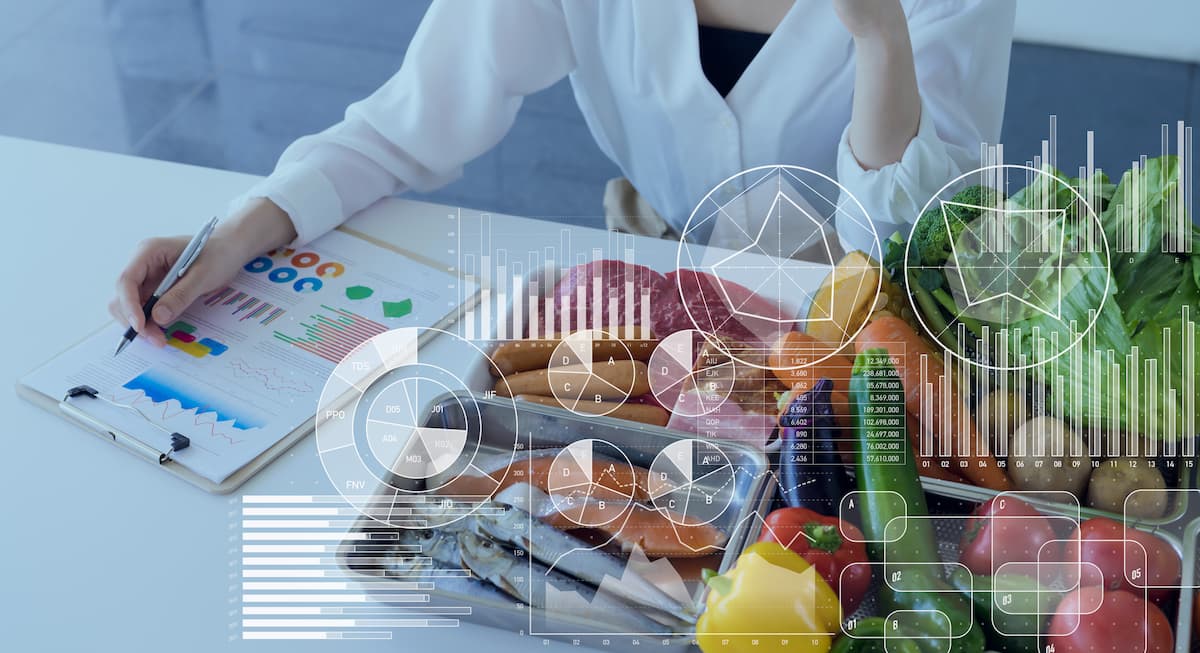
In this part of the article, we give you an overview of recipe management needs by industries:
Recipe management generally functions the same throughout different industries. The system is used to store product-related information and serve as a guide for verifying the production process. Despite this, recipe management's use may be slightly more comprehensive in some industry operations than others.
The following section discusses how a recipe management system can help different industry sectors and which features are most useful for each sector.
Food manufacturing businesses operate on a large scale. They produce food items sold in retail stores or other food businesses. A recipe management system functions in a manufacturing setting as an overall guide for large production batches.
Specifically, recipe management in manufacturing functions as the following:
Depending on the product demand, the manufacturing scale may constantly differ, especially for plant-specific recipes. Using recipe management, manufacturers can constantly scale the recipe output without compromising the products. The system is also used to locate approved alternative ingredients instantly in case an ingredient runs out. It makes substitutions an easy task.
Manufacturing companies also use highly technical daily operations that require expertise from employees. Instructions and special remarks on processing ingredients for a particular product can be noted using recipe management. The system can then be used to detect inefficient and inconsistent operations to boost performance.
Unlike manufacturing businesses, food service businesses must address front-of-the-house, or food service area, and back-of-the-house, or kitchen area, operations. Recipe management for food service mainly involves providing solutions for back-of-the-house standard processes.
The main solutions of recipe management for food service include:
Managing recipes in food service mean organizing inventory and maintaining the quality of dishes produced in the kitchen.
Food service businesses can immediately assess the profitability of every dish on their menu using recipe management. If in case the cost is significantly increasing, a previously uploaded alternative recipe can be used to maintain profitability and quality.
The system can help standardize recipe selection while reducing the likelihood of errors and inconsistent quality. It should also help restaurants manage allergens and other hazards by remarking which ones apply to your food business.
While recipe management systems mainly cater to food businesses that handle and prepare food from scratch, the system can also be very helpful for retailers.
For retail businesses, recipe management functions should include:
Retailers can use recipe management to document allergen information about the products that the business offers. This feature can guide customers in making more informed decisions regarding the products that they buy.
Food retailers can use the management system to compile information and manage potential food safety hazards much better.
Recently, the uses of a recipe management system have become wider. Recipe management software systems give restaurant businesses automatic solutions that help keep profitability while managing all product-related information. To date, the software can do more than just store correct recipes. The software ensures the consistency and safety of the products you serve to your customers
Powerful recipe management software also allows integration with other programs, such as inventory management software and a point-of-sale system. Such integrations can help improve the efficiency of raw material procurement, costing, and accounting of revenues.
Recipe management software is a type of restaurant software that is mainly used to store recipes and related information to serve as a guide for food handlers. It allows for a better overview and easier access to recipe operations.
At FoodDocs, you can get the core features of recipe management software and a food safety system in one digital solution. You can explore how our system can help you manage recipes and food safety at the same time by using our free 14-day trial.
Learn more about food safety compliance through our detailed food safety rules and tips.
Programs for managing recipes and operations in a food business have a lot of varieties. Two of the commonly used programs for recipe management are recipe management software and recipe book software. Although closely related, these two programs have different functions and target markets.
Recipe book software, otherwise known as cookbook software, is mainly used to create cookbook-style recipe documents containing your favorite meals. Customers use this software to translate printed recipes into a neatly presented cookbook complete with the ingredients, instructions, and images of the final product. It can also compile online recipes.
Recipe book software programs also help in calculating the nutritional info of a recipe that you input. The software lays out the information ready for printing or sharing. Most cookbook programs also allow you to print out the ingredients to become a grocery list or for making meal plans. This program acts as a simple recipe organizer software.
On the contrary, food recipe management software can do more. This software can do all the mentioned features of cookbook software plus other operations. The recipe management software can control and present ingredient and product costs for food businesses. It can also be used as recipe analysis software for substitutions of ingredients in recipes.
The main customers of recipe management software are food businesses that deal with great and varying ingredient demands. On the other hand, recipe book software is more of an everyday tool for aspiring chefs who aim to publish their cookbooks.
Active recipes hold the secrets of any food business. They contain the ingredients and processes needed to produce your best-selling menu items. In addition, recipes serve as the main guide for food handlers when producing your dishes.
Recipe management software can help you ensure that these recipe functions are always done correctly and consistently at all times. To show you how important recipe management systems have become for food businesses, here are some benefits of recipe management software:
A recipe management system makes essential information about your production recipes more accessible. Food handlers become more aware of any potential food safety hazards, such as allergens, in the food they are preparing.
While improving transparency, the recipe management software simultaneously promotes the protection of your information. Only employees with user permissions will be given access to important recipes, protecting your trade secrets.
When using recipe management software, you can ensure that the product quality and safety that come up every time are reproducible and consistent. A detailed recipe will show the critical steps in making the product, which will make or break the outcome. When your business consistently produces the same product quality, you can expect to gain supporters or repeat customers.
A recipe management system can be used to familiarize and train food handlers. Giving food handlers access to a recipe allows them to review the production processes and ensure they know what to look for when preparing the food. They can also become more familiar with the alternative operations should a recipe ingredient be unavailable.
The software makes it easier to scale down or upsize a recipe's requirements with very little margin of error. Employees would not need to calculate the ingredient quantities manually. In addition to software, you can use our Recipe Converter Calculator to scale recipes for free.
Using a recipe management system allows food business supervisors to integrate their systems with other software programs, such as an inventory management system. Doing this lets your team get a quick overview of stock levels and receive prompts if you need to reload supplies.
Recipe management software can automatically provide real-time ingredient prices and automatic food cost calculations. With such a feature, you can always stay on top of your expenses and easily substitute costly ingredients with other approved recipe materials that cost less.
The standardized process offered by recipe management software minimizes the risk of contamination from food hazards.
Food handlers can note important remarks or instructions required by food laws in a recipe management system. The system can help ensure that hazardous ingredients, such as allergens, are correctly handled.
A recipe management system works more than just as a compilation program of recipes. It levels up the usual Recipe Card Generator by equipping it with smart solutions. It can help you maximize and make your operations more efficient. At FoodDocs, you can get the core benefits of a recipe management system combined with more features for food safety management.
Our digital Food Safety Management System features comprehensive food safety solutions to maintain compliance while allowing you to manage your recipes and production processes. Use our recipe management feature to log your recipes and essential information and effortlessly perform recipe calculations for your production.
You can learn more about our recipe management features connected to a food safety system in the last section of this blog post.

Food businesses have a lot of choices when it comes to recipe management systems. The key to selecting which one fits best for your operations is understanding which functions are critical for recipe management.
We've prepared a list of the critical factors that an effective recipe software system should have.
The main function of a recipe management system is to be able to hold all your recipe procedures, and related documents, such as final product images, safety sheets, shelf-life data, and production records. It serves as recipe database software or centralized recipe storage where you can archive electronic records of your recipes for your team.
The software must allow customizations of recipes while maintaining consistent quality, as recipe adjustments may constantly occur. For example, if a staple recipe ingredient becomes phased out, you must be able to revise the recipe according to the available alternatives.
An effective recipe manager software can offer insightful information for cost management. The software that you will choose must be able to show you updated recipe costing for each product or dish on your menus. Manually computing food costs can lead to more errors. Programs equipped with a food cost calculator are significantly more preferred as true costs are essential for running your business.
The recipe management system must be able to accurately downsize or upscale your recipes according to the base formulation you provided. Your team must be able to rely on the software to do the calculation and provide accurate values of required ingredients for larger or smaller batch processes.
As the software name suggests, it can improve efficiency in managing new and old versions of your master recipes. The software must be able to indicate which recipe variation is currently being used as the control recipe and which one is the closest to the standard recipe in case of process changes.
Recipe management systems are designed to identify allergenic ingredients in your recipes and intuitively highlight them for guidance. Some programs, like FoodDocs digital FSMS, are smarter as they can detect which allergen concerns are relevant to your business based on your locations. Find out which food allergens apply to your location from our Food Allergen Chart.
Advanced management systems allow food handlers to generate nutritional information about the ingredients used in a dish. Using this feature, you can offer more value and insight to your customers.
This management feature can boost efficiency in communication and in spreading information throughout your team. As there is no need to print everything and share recipes manually, your team can adapt to major changes in an instant.
When integrated with other software programs, a recipe management system can become more useful. Integrating the system into menu engineering software can help you update product costs according to the most profitable margins intuitively. Another example is when you connect the system to an inventory management system, you can get real-time reports of which products move fast and which are still high in stock.
Choosing a recipe management system can be very tough, especially with all of the available choices. At times, you would only need some of the mentioned parameters for your operations. Some programs may be too complicated and have unnecessary functions that take away the focus from the important ones .
What you need is software that has the essential functions of a recipe management system. At FoodDocs, you can get these functions in addition to a digital Food Safety Management System. Our food safety software features a built-in recipe management system that can do core functions, such as recipe digitization, recipe scaling, and allergen management.
Implementing recipe management can boost your everyday efficiency. It can help you improve kitchen operations and reduce potential errors that may lead to unwanted hazards.
To ensure that your team and food business are getting the full potential of a recipe management system, follow these tips:
The software itself can be used to onboard new operators. For existing team members, you would need to orient them on how to optimize operations with the software. All food handlers must understand the functions of the software and become aware of any updates in the system. You can integrate training during the onboarding process for your food employees using our free food safety guidelines pdf.
This type of software aims to minimize errors. Miscalculations from manual computations can cost you quite a lot, especially when the error is related to the formulation. You can reduce errors and tedious tasks that are prone to mistakes using the software.
Another way to minimize errors and improve accuracy is to mass upload all of your recipes in the software all at once. Manually inputting each recipe into the software increases the risk of mistyping a piece of information.
When scaling your recipes, the calculations will be based on the main recipe you upload. Make sure that your original recipe is correct and accurate, or else all calculations will be wrong.
Always input substitute recipes in case of ingredient shortage. Recipe management systems can help you update a recipe based on available recipes and communicate throughout the entire team the substitute recipe. In this way, you can ensure a seamless operation without any downtime.
This feature is one of the most vital parts of a restaurant management system. Make sure that employees understand why particular ingredients are highlighted by the system automatically and how the feature contributes to your in-house allergen control program.
Although the software automates recipe management, communicating changes to employees is still an important task to ensure clarity throughout the team.
Another vital feature of recipe management is calculating recipe costs. Food business restaurant managers must take advantage of this feature as it will determine if a dish is still profitable or if it requires changes, such as ingredient substitutions.
While a standalone recipe management software offers many benefits and features, having other systems, such as a food safety management system, can boost its functionality. At FoodDocs, you can get the best of both worlds. You can digitize handwritten recipes and get overviews of important recipe information while maintaining food safety compliance in all operations.
In this part of the article, we highlight the two main benefits of FoodDocs software:
Recipe management plays a significant role in maintaining food safety. These two aspects are inseparable and must be monitored consistently. Proper recipe management can boost efficiency and help your team resolve bottlenecks in operation while reducing the risk of food safety hazards.
At FoodDocs, we've combined the core features of an advanced recipe management solution and food safety management system in one smart software.
Powered by artificial intelligence and a machine-learning program, our software offers intuitive solutions that can help businesses maintain compliance at all times. With consistent improvements and development, our team has incorporated recipe management features into our Food Safety System Software.
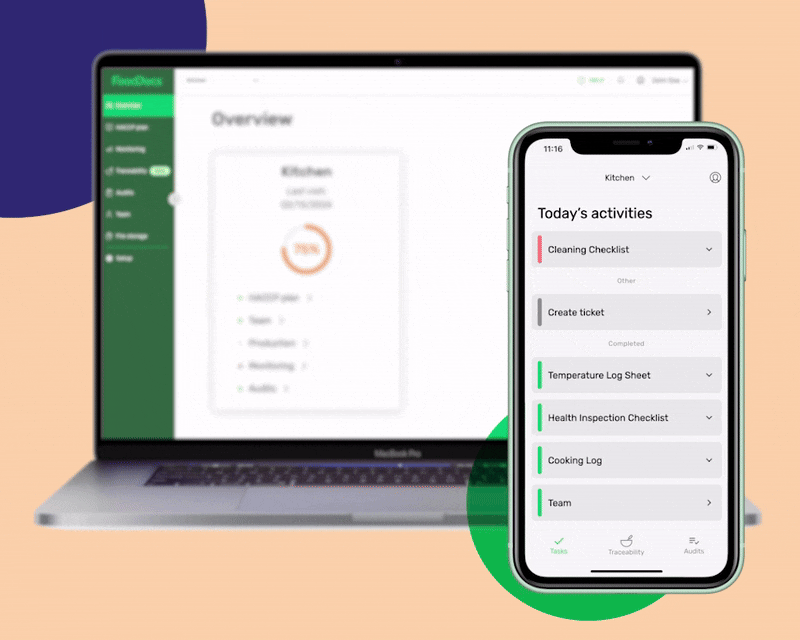
FoodDocs digital Food Safety Management System now features recipe management functions. You can upload all of your business recipes into our system and access them from your device.
In addition to archiving your recipes, our system can offer you the following benefits:
This feature also allows you to download the recipes and share them with your employees.
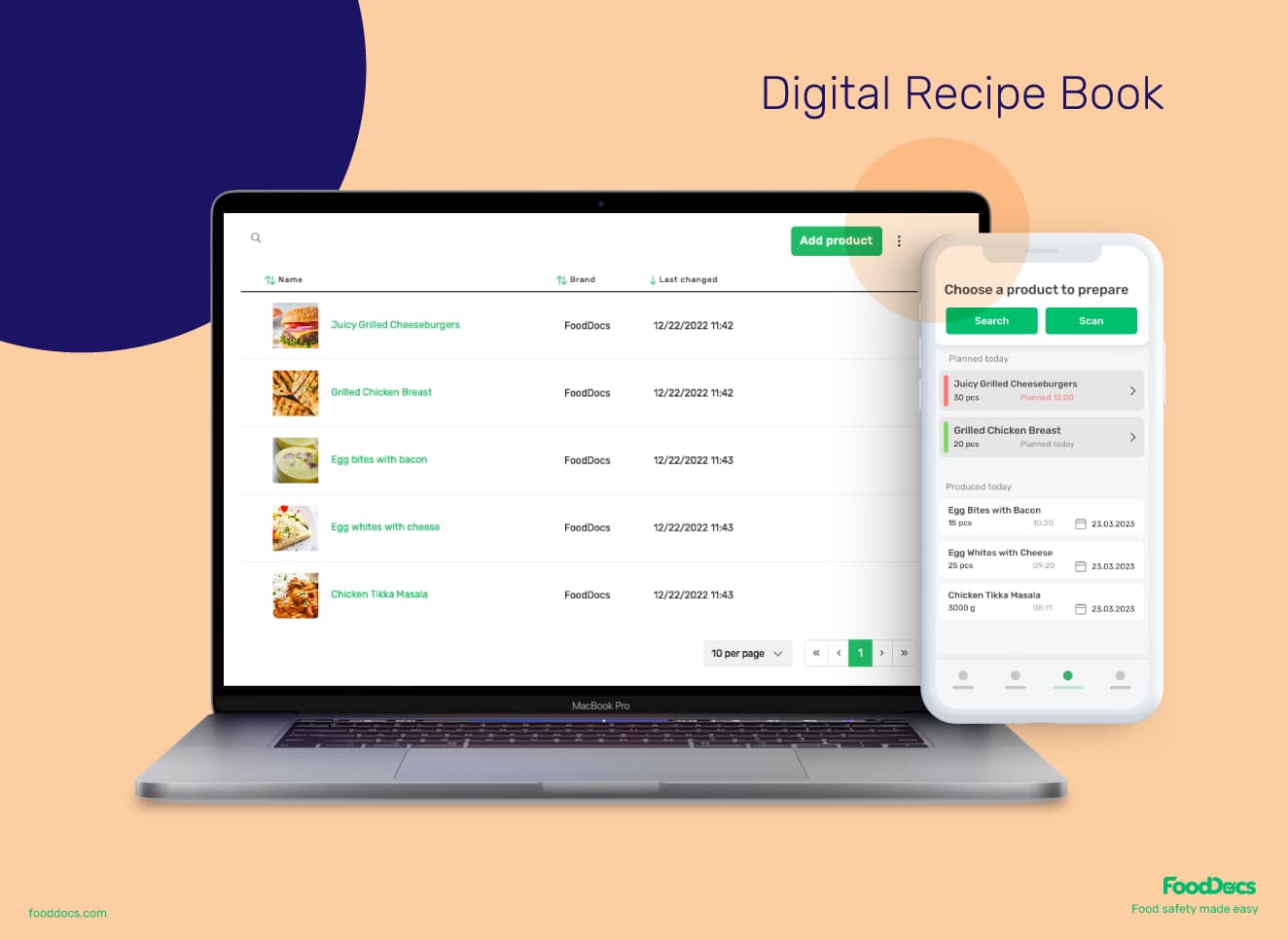
Create and scale your recipes accurately using our recipe management features. Maintain food safety and quality consistently by establishing your standardized recipe and detailed instructions in our digital platform.
Recipe management is just the first of many features that our food safety software can provide. Using our digital Food Safety Management System, you can manage your production remotely and create schedules efficiently.
Here are some of the most useful features that our system can provide your team:
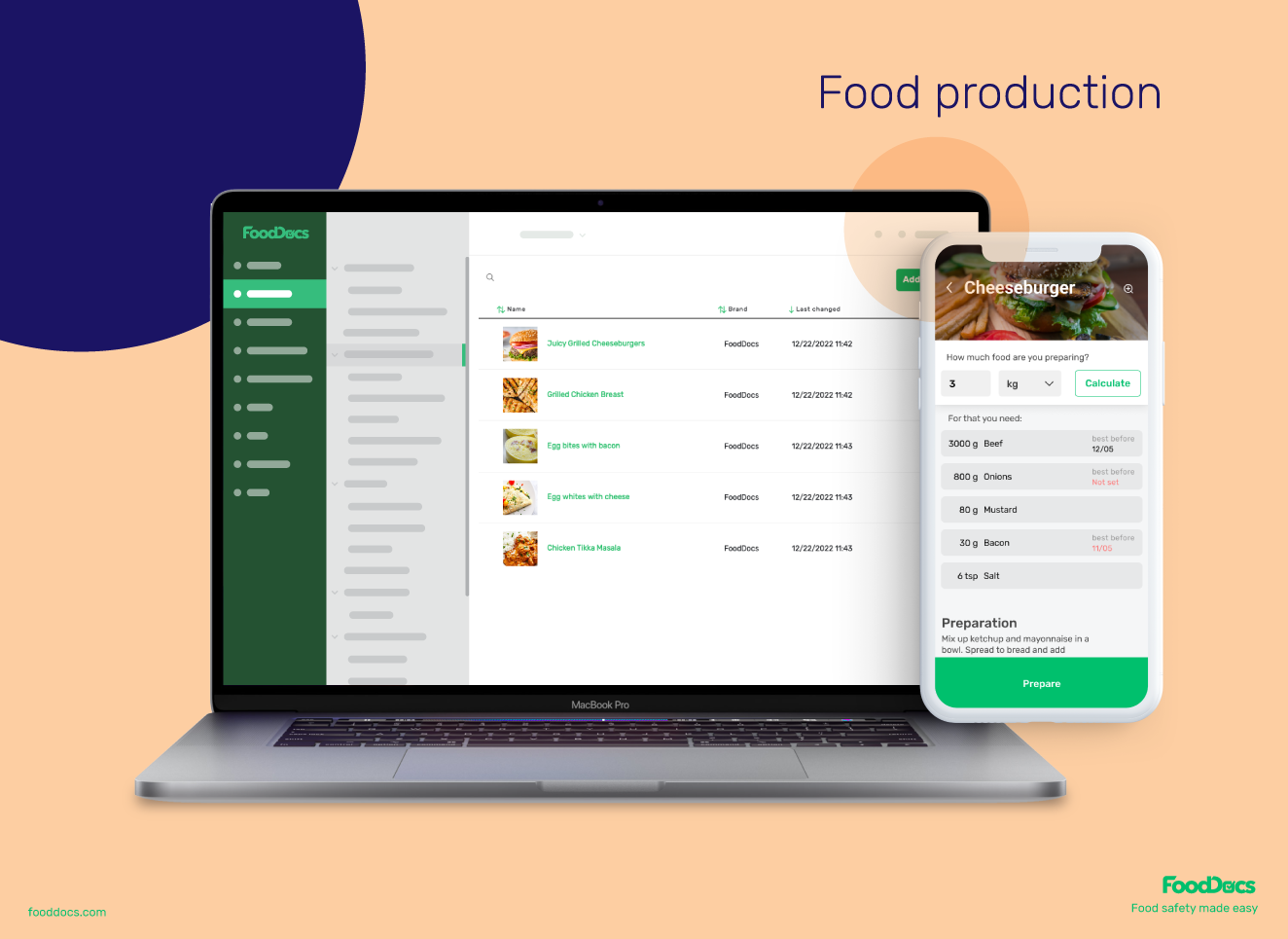
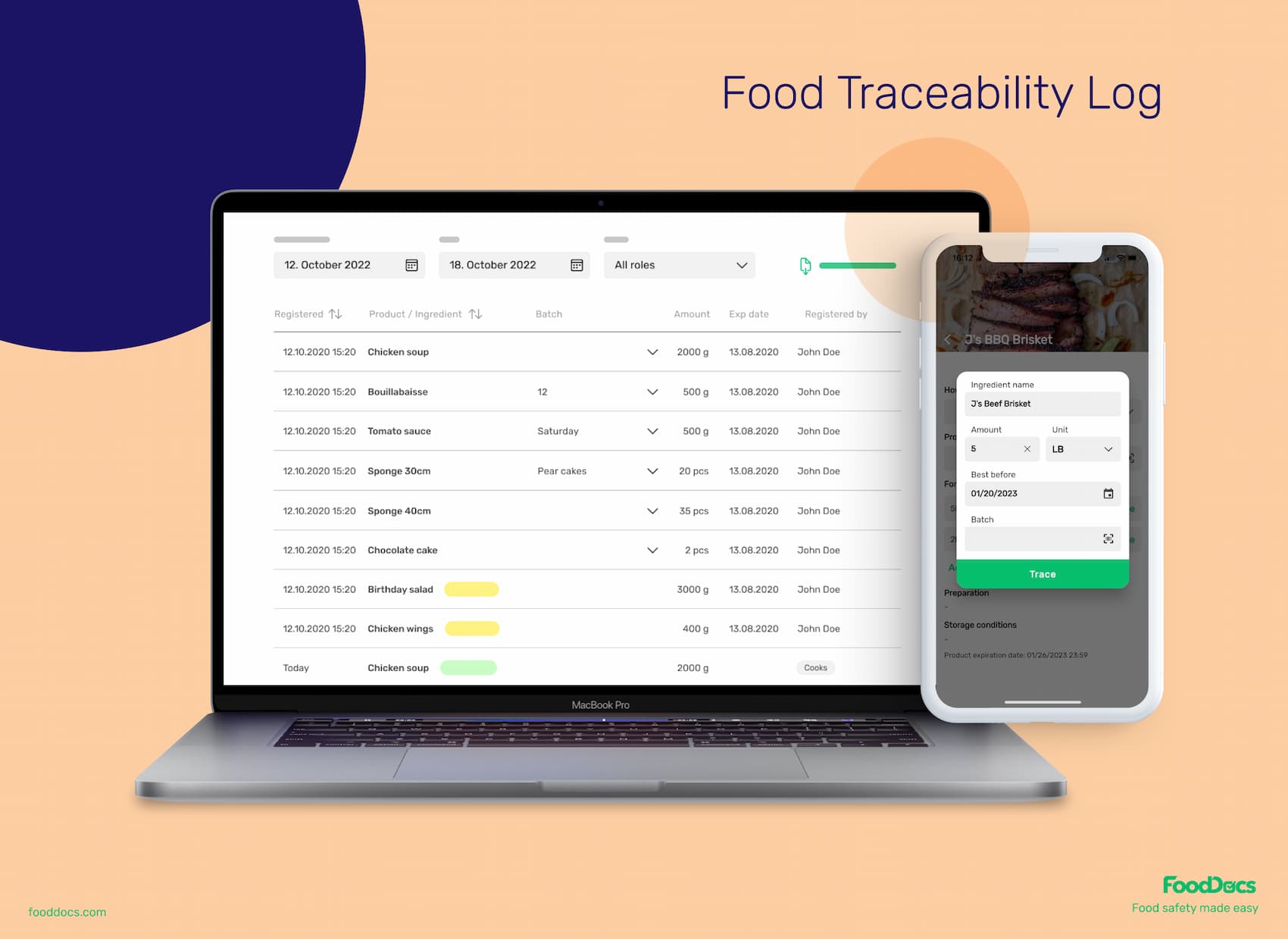
You can start using all of these features and more in just 15 minutes. Our system only requires you to answer a few basic questions about your business operations. Using artificial intelligence, all necessary food safety logs and documents will be automatically generated for your team.
Customize recipes, monitoring logs, and checklists anytime you want. Switch to our digital Food Safety Management System and control your recipes and food safety compliance remotely.
Learn what Standard Operating Procedures (SOPs) are and how to write effective SOPs that ensure consistency, efficiency, and safety in your...
Boost your retail food safety with essential practices and digital tools to protect customers and your brand. Plus a free Retail Food Safety Leader...
Discover how Bakery 79 achieved top food safety compliance and 5-star EHO ratings with FoodDocs across 12 locations, driving growth and operational...